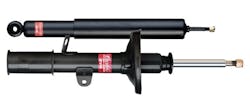Shocks and struts are usually an optional purchase consumers may make when the performance of the original parts no longer meets their expectations. That translates into an opportunity for you and your technicians to ask the right questions. If you don’t, or if you fail to listen to the answers, you won’t know what your customers really need when it comes to shocks and struts.
KYB Americas Corp. suggests technicians always ask customers how they use their vehicle and their performance expectations for it. “Add-on trailer hitches, carrying heavier loads, off road use and improved handling above the original design are just some of the possible reasons that we might recommend a shock capable of doing more,” says Mac McGovern, director of marketing and training for KYB.
Sometimes the customer is looking to upgrade to a larger tire and wheel package or use the vehicle in a way that calls for a different technology, according to Bill Dennie, director, ride control channel management for Tenneco Inc., the manufacturer of Monroe shock absorbers and struts. “Our Rancho shocks and struts are an excellent choice for truck, Jeep and SUV owners who want to use their vehicles in an off-road environment or at least want to achieve a more aggressive look with larger tires and wheels.”
The right questions can identify customers whose vehicles periodically carry heavier loads or tow a trailer, says Dennie. “The tire dealer might want to recommend an upgrade to our Load-Adjusting Shocks, air-adjustable Max-Air shocks or nine-position adjustable Rancho RS9000XL shocks.”
An installer’s first step is to see what products are offered for an application, says Ted Wittman, senior technician, Ride Control LLC, which offers the Gabriel line. Next, ask what the customer thinks of the vehicle’s current performance, how the vehicle will be used, how long it will be kept, plus the type of ride he or she prefers. Finally, discuss the best solution based on the answers.
“If the vehicle is strut-equipped, there may be struts and ReadyMount premium pre-assembled struts available. Does it make sense to step up to a complete assembly? It’s important to explain the financial benefits associated with a ReadyMount assembly,” he says.
Truck and utility vehicles usually equipped with shock absorbers require a detailed discussion since these vehicles vary greatly in usage requirements. “Premium features of the product that enhance durability or product life, such as chrome plating on all rods and premium drawn over mandrel (DOM) tubing, are helpful to consider and communicate to the customer as they can help sell,” says Wittman.
The majority of MacPherson strut-equipped vehicles do not have a performance upgrade choice available. These vehicles are typically designed to meet the needs of motorists who will use the vehicle within its designed capability. Shocks are different, according to KYB’s McGovern.
“With shocks, there are choices,” he says. If a customer is not concerned about ride comfort, but needs extra load control, a heavy-duty shock may meet the need. If they want both, McGovern recommends a monotube design. “Monotubes use a high pressure gas chamber that only delivers extra damping force when required, but always improves steering responsiveness. The customer will experience added control, but will still have a near but above original equipment ride.”
Understanding the brand and replacement part’s purpose is the key to matching the customer’s expectations. The other concern is price, says McGovern. “You usually get what you pay for. As the cost goes down, something usually has to be sacrificed. It could be in the fit, how well it performs or how long it lasts.”
Since a replacement shock or strut is not bound by the OEM design, technicians have another opportunity to ask questions that can close the sale.
“It’s just as important to ask the customer about quality preferences,” says McGovern. “Don’t assume the customer only wants a low price. Most people, once they understand the value and risk, will choose a better part.” ■
About the Author

Ann Neal
Ann Neal is a former senior editor at Modern Tire Dealer.
